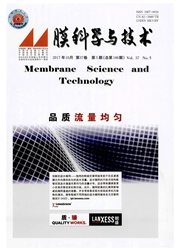

 中文摘要:
中文摘要:
将十二烷基硫酸钠 (SDS) 与孔径5 nm的陶瓷膜结合,探索胶束增强陶瓷膜法处理镧离子废水的可行性。考察了SDS浓度、跨膜压差 (TMP)、溶液pH值等因素对陶瓷膜过滤性能的影响。结果表明,随着SDS浓度的增大,陶瓷膜对La^3+ 的截留率从70% 增大到99.9%;当SDS浓度大于临界胶束浓度 (CMC) 后,膜对La^3+ 的截留率略有降低,大约维持在95%-97% 左右;膜通量则随SDS浓度增大先减小后增大,最后趋于65 L·m^-2·h^-1·bar[换算成MPa]-1。随着TMP提高,膜通量基本呈线性关系增大,膜对SDS和La^3+ 的截留率略增大。随着溶液pH的升高,渗透通量略有下降,膜对La^3+ 和SDS的截留率均显著增加。采用体积浓度为0.5% 的稀硝酸清洗污染的陶瓷膜,膜的纯水通量可恢复到95% 以上,重复性好。
 英文摘要:
英文摘要:
The feasibility of the micellar-enhanced ultrafiltration(MEUF) process for removing La^3+ using the anionic surfactant sodium dodecyl sulfate (SDS) was evaluated. The effects of different parameters on the separation performance of 5 nm ceramic membrane were investigated including the concentration of SDS, transmembrane pressure (TMP) and solution pH. It was found that when the SDS concentration exceeded the critical micelle concentration(CMC), the rejection of La^3+ was among 95%-97% with little change. The flux increased firstly and then decreased with the increase of SDS concentration and finally tended to 65 L/(m^2 · h). The permeate flux increased linearly and the rejection of La^3+ and SDS had a slight increase with the increasing of TMP. With increasing solution pH, the permeate flux decreased slightly, but the rejections of La^3+ and SDS increased significantly. Finally, the ceramic membrane was washed with 0. 5% (vol%) HNOa and the pure water flux could be recovered above 95% effectively, and the flux of the ceramic membrane had a good reproducibility.
 同期刊论文项目
同期刊论文项目
 同项目期刊论文
同项目期刊论文
 Synthesis of Pd@ZIF-8 via an assembly method: Influence of the molar ratios of Pd/Zn2+ and 2-methyli
Synthesis of Pd@ZIF-8 via an assembly method: Influence of the molar ratios of Pd/Zn2+ and 2-methyli Preparation and Characterization of SiC Whisker-Reinforced SiC Porous Ceramics for Hot Gas Filtratio
Preparation and Characterization of SiC Whisker-Reinforced SiC Porous Ceramics for Hot Gas Filtratio Enhanced Catalytic Properties of Palladium Nanoparticles Deposited on a Silanized Ceramic Membrane S
Enhanced Catalytic Properties of Palladium Nanoparticles Deposited on a Silanized Ceramic Membrane S Fabrication of ceramic membranes with controllable surface roughness and their applications in oil/w
Fabrication of ceramic membranes with controllable surface roughness and their applications in oil/w Application of ceramic membranes in the treatment of oilfield-produced water: Effects of polyacrylam
Application of ceramic membranes in the treatment of oilfield-produced water: Effects of polyacrylam Insights into membrane fouling of a side-stream ceramic membrane reactor for phenol hydroxylation ov
Insights into membrane fouling of a side-stream ceramic membrane reactor for phenol hydroxylation ov Catalytic activity of palladium nanoparticles immobilized on an Amino-functionalized ceramic membran
Catalytic activity of palladium nanoparticles immobilized on an Amino-functionalized ceramic membran One-stepContinuous Phenol Synthesis Technology vi a Selective Hydroxylation of Benzeneover Ultrafine
One-stepContinuous Phenol Synthesis Technology vi a Selective Hydroxylation of Benzeneover Ultrafine Cleaning ceramic membranes used in treating desizing wastewater with a complex-surfactant SDBS-assis
Cleaning ceramic membranes used in treating desizing wastewater with a complex-surfactant SDBS-assis Enhanced catalytic properties of Pd nanoparticles by their deposition on ZnO-coated ceramic membrane
Enhanced catalytic properties of Pd nanoparticles by their deposition on ZnO-coated ceramic membrane One-step semi-continuous cyclohexanone production via hydrogenation of phenol in a submerged ceramic
One-step semi-continuous cyclohexanone production via hydrogenation of phenol in a submerged ceramic Palladium nanoparticles supported on a two-dimensional layered zeolitic imidazolate framework-L as a
Palladium nanoparticles supported on a two-dimensional layered zeolitic imidazolate framework-L as a Unusual Air Filters with Ultrahigh Efficiency and Antibacterial Functionality Enabled by ZnO Nanorod
Unusual Air Filters with Ultrahigh Efficiency and Antibacterial Functionality Enabled by ZnO Nanorod 期刊信息
期刊信息
